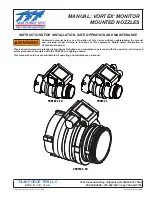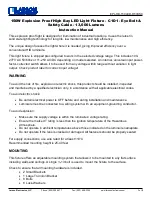
neoBLUE
®
mini System User Manual
P/N 051440D
7
4. Assembly and Operating Instructions
4.1 Setting Up the Device
1. Attach the arm only to the manufacturer’s specified location on the radiant warmer or
incubator. If an open bed or bassinet is being used, attach the arm to a free-standing pole
that meets the requirements for safety listed below. Attach the power cord to the power
supply and plug into AC outlet.
Warning! Attachment of Arm with Pole Mount:
When attaching the light
to any floor standing pole, the user must validate that EN 60601-1/UL2601-1
standards for stability in normal use is met.
Warning! Attachment of Arm with Pole Mount:
Ensure that the pole
mount is properly seated around pole prior to use to prevent slippage during use.
Ensure that all screws and bolts are secure prior to use.
Warning! Weight Limitations of Arm:
The arm has been validated to hold
the weight of the light enclosure only. Do not hang anything from the arm or
power cord.
Warning! Arm Adjustments:
The arm folds into itself for optimal space
utilization. Use care when repositioning the arm to prevent pinching yourself.
2. Check intensity. Before use, check the intensity of the light using a spectrophotometer per
your institution’s procedures (see Section 6.1, “Checking the Light Intensity”). The light
has been calibrated with the Ohmeda BiliBlanket® Meter II to deliver a peak intensity of
30-35 µW/cm2/nm at a 12 inch (30.5 cm) distance from the baby. Please refer to section 9
of this manual or Tech Note, P/N 051124 for information on other meters.
4.2 Preparing Infant for Phototherapy
1. Prepare infant. The infant may lie in an open bed, incubator, bassinet, or radiant warmer.
Warning!
Select only infants for whom phototherapy has been prescribed.
2. Shield infant’s eyes with protective eye shields, such as Biliband™ Eye Protectors,
designed for use during phototherapy.
Warning! Eye Protection:
Do not look directly into the LEDs. During treatment,
always protect the baby’s eyes with eye patches or equivalent. Periodically and/or per
your hospital protocol, verify that the baby’s eyes are protected and free of infection.
3. Position light over infant. Position the face of the light enclosure towards the infant. The
light enclosure can be tilted by grasping the device and/or gooseneck. Gross movements
should be made with the arm while finer adjustments can be made with the light enclosure
and gooseneck. The light enclosure swivels around the gooseneck to facilitate proper
targeting.


































